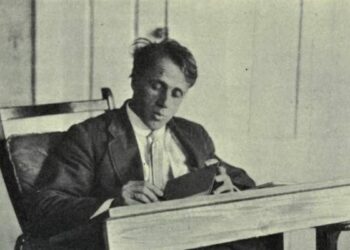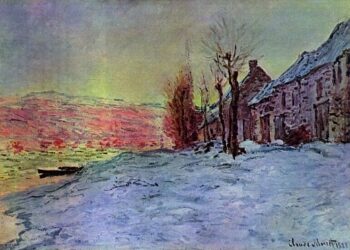Introduction
Crossing The Bar Summary By Alfred Lord Tennyson“Crossing the Bar” is a poignant poem by Alfred, Lord Tennyson, written in 1889 and published posthumously. This brief but powerful work encapsulates Tennyson’s contemplation of death and the transition from life to the afterlife. The poem serves as an allegory for the journey into death, portrayed through the metaphor of a ship departing from the harbor. With its evocative imagery and emotional resonance, “Crossing the Bar” has become one of Tennyson’s most celebrated pieces, reflecting his deep personal reflections on mortality, faith, and the possibility of an afterlife.
In this summary, we will explore the poem’s structure, themes, literary devices, and its significance within Tennyson’s oeuvre and its place in English literature.
Summary of the Poem
“Crossing the Bar” consists of four quatrains, employing a regular rhyme scheme and meter that contribute to the poem’s rhythmic and musical quality. The poem opens with a speaker who contemplates the act of crossing the metaphorical bar, which represents the boundary between life and death.
READ MORE
Stanza Breakdown
Stanza 1: The Setting and Departure
In the opening stanza, Tennyson introduces the setting of the poem, which occurs at sunset. The speaker describes a peaceful scene as the sun sets on the horizon, symbolizing the end of a day and, by extension, the end of life. The imagery evokes a sense of calm and tranquility, suggesting acceptance of the inevitable journey ahead.
The term “bar” serves as a critical metaphor in this stanza. It represents both the physical barrier of the sandbar at the mouth of a harbor, which boats must cross to enter the open sea, and the metaphorical barrier between life and the afterlife. The speaker prepares to embark on this journey, indicating a readiness to leave behind the familiar shore of life.
Stanza 2: The Call of the Sea
As the speaker prepares to cross the bar, he reflects on the presence of his ship, which symbolizes his soul. The ship is ready to set sail, representing the transition into the unknown. The sea is portrayed as vast and infinite, suggesting the mystery of the afterlife that lies beyond the physical world.
The imagery of the sea further emphasizes the themes of exploration and adventure, but also the fear and uncertainty associated with death. The speaker expresses a desire to meet his “Pilot,” a reference to a guiding figure, often interpreted as God or a spiritual force that will lead him through the journey into the afterlife. This desire for guidance underscores the speaker’s faith and hope for a safe passage.

Stanza 3: Acceptance of Mortality
In the third stanza, Tennyson deepens the exploration of mortality. The speaker acknowledges the inevitability of death, reflecting a sense of resignation to his fate. There is an acceptance of the cycle of life, where one must eventually face the end of their earthly existence. The imagery of the “bar” reinforces this idea, marking the transition from life to death.Crossing The Bar Summary By Alfred Lord Tennyson
The speaker conveys a sense of peace in this acceptance, suggesting that the act of crossing the bar is not to be feared, but rather embraced as a natural part of life’s journey. This acceptance reflects Tennyson’s own views on mortality, shaped by personal experiences, including the loss of loved ones.
Stanza 4: Hope and Reassurance
The final stanza of the poem captures a tone of hope and reassurance. The speaker expresses a wish that those he leaves behind should not mourn his passing. Instead, he encourages them to see his crossing as a natural progression rather than a tragic loss. The imagery of the “sunset” evokes a sense of beauty in the transition, reinforcing the idea that death is not an end but a continuation of existence in another form.Crossing The Bar Summary By Alfred Lord Tennyson
The concluding lines emphasize the speaker’s faith in the afterlife and the hope of reuniting with loved ones. The metaphor of the Pilot takes on a deeper significance, representing divine guidance and the belief that there is a purposeful journey beyond death. The poem closes with a sense of calm assurance, leaving readers with a feeling of peace regarding the mysteries of life and death.Crossing The Bar Summary By Alfred Lord Tennyson
READ MORE
Themes
1. Death and Mortality
A central theme of “Crossing the Bar” is the contemplation of death and mortality. Tennyson reflects on the inevitability of death, portraying it as a natural part of life’s journey. The poem invites readers to consider their own mortality and the transitions that accompany it, ultimately fostering a sense of acceptance regarding the end of life.
2. Faith and Spirituality
Tennyson’s exploration of faith is another significant theme in the poem. The speaker’s reference to the “Pilot” symbolizes divine guidance and the assurance that there is a purposeful journey awaiting beyond the physical realm. The poem conveys a message of hope, suggesting that faith can provide comfort in the face of mortality.
3. The Transition from Life to Afterlife
The metaphor of crossing the bar serves as an allegory for the transition from life to the afterlife. Tennyson emphasizes that this journey is not to be feared but embraced as a natural progression. The imagery of the sea and the horizon represents the unknown, inviting contemplation of what lies beyond life.
4. Acceptance and Resignation
Throughout the poem, the speaker expresses a sense of acceptance regarding death. There is a resignation to the inevitability of crossing the bar, suggesting that embracing mortality can lead to a peaceful state of mind. This theme of acceptance reflects Tennyson’s personal experiences with loss and the need to come to terms with the impermanence of life.Crossing The Bar Summary By Alfred Lord Tennyson
5. Hope and Reassurance
The poem ultimately conveys a message of hope and reassurance. The speaker encourages those left behind not to mourn but to view death as a continuation of existence. This hopeful outlook emphasizes the belief in the afterlife and the possibility of reunion with loved ones, providing comfort in the face of loss.
Literary Devices
1. Metaphor
The central metaphor of the “bar” represents the boundary between life and death. Tennyson uses this metaphor to explore the transition from the known world to the unknown, inviting readers to reflect on the nature of existence and the journey into the afterlife.Crossing The Bar Summary By Alfred Lord Tennyson
2. Imagery
Tennyson employs vivid imagery throughout the poem, particularly in his descriptions of the sunset, the sea, and the ship. This imagery enhances the emotional resonance of the poem, allowing readers to visualize and feel the experience of crossing the bar.
3. Personification
The speaker addresses the sea and the ship in a way that imbues them with human qualities. This personification emphasizes the intimate relationship between the speaker and his surroundings, reinforcing the theme of connection between life and death.Crossing The Bar Summary By Alfred Lord Tennyson
4. Symbolism
Various symbols appear throughout the poem, such as the “Pilot,” which represents divine guidance. The sunset symbolizes the end of life, while the sea represents the vast unknown of the afterlife. These symbols enrich the poem’s themes and deepen its meaning.Crossing The Bar Summary By Alfred Lord Tennyson
5. Rhyme and Meter
Tennyson’s use of regular rhyme and meter contributes to the poem’s lyrical quality. The rhythmic structure mirrors the natural flow of life and death, creating a sense of harmony that underscores the themes of acceptance and reassurance.Crossing The Bar Summary By Alfred Lord Tennyson
READ MORE
Conclusion
“Crossing the Bar” stands as one of Alfred, Lord Tennyson’s most significant and moving works, encapsulating his reflections on death, mortality, and the hope of an afterlife. Through its evocative imagery, poignant themes, and masterful use of literary devices, the poem invites readers to contemplate their own journeys and the connections that transcend life and death.
Tennyson’s exploration of mortality is rooted in personal experiences, allowing the poem to resonate deeply with audiences. The metaphor of crossing the bar serves as a powerful reminder of the inevitable transitions we all face, while the speaker’s faith and acceptance provide comfort in the face of uncertainty.
In the context of English literature, “Crossing the Bar” exemplifies Tennyson’s skill as a poet and his ability to grapple with profound philosophical questions. The poem continues to inspire readers, offering a timeless message of hope and reassurance as they navigate the complexities of life and the inevitability of death.Crossing The Bar Summary By Alfred Lord Tennyson

FAQ
1. What is the main theme of “Crossing the Bar”?
The main theme of “Crossing the Bar” is the contemplation of death and the transition from life to the afterlife. Tennyson explores the inevitability of death, the importance of faith, and the hope of reunion with loved ones.
2. What does the “bar” symbolize in the poem?
The “bar” symbolizes the boundary between life and death. It represents the transition that individuals must make as they journey from the known world into the unknown of the afterlife.
3. How does Tennyson express acceptance of mortality in the poem?
Tennyson expresses acceptance of mortality through the speaker’s reflections on the inevitability of death. The speaker embraces the crossing of the bar as a natural part of life’s journey, suggesting that it should not be feared but rather accepted.
4. What role does faith play in “Crossing the Bar”?
Faith plays a significant role in the poem, as the speaker expresses a desire to be guided by the “Pilot,” symbolizing divine guidance. This faith provides comfort and reassurance regarding the journey into the afterlife.
5. How does the poem address the concept of hope?
The poem conveys a message of hope by encouraging those left behind not to mourn the speaker’s passing. Instead, the speaker invites them to view death as a continuation of existence and the possibility of reunion with loved ones.Crossing The Bar Summary By Alfred Lord Tennyson
6. What literary devices does Tennyson use in the poem?
Tennyson employs various literary devices, including metaphor, imagery, personification, symbolism, and rhyme and meter. These devices enhance the poem’s emotional depth and reinforce its central themes.
7. What is the significance of the imagery of the sea in the poem?
The imagery of the sea symbolizes the vast unknown of the afterlife and the journey one must undertake when crossing from life into death. It evokes feelings of exploration, mystery, and the acceptance of mortality.
8. How does “Crossing the Bar” reflect Tennyson’s personal experiences?
The poem reflects Tennyson’s personal experiences with loss and his contemplation of mortality. His reflections on death and the hope for an afterlife are influenced by the deaths of loved ones, shaping the emotional resonance of the poem.Crossing The Bar Summary By Alfred Lord Tennyson
READ MORE

















